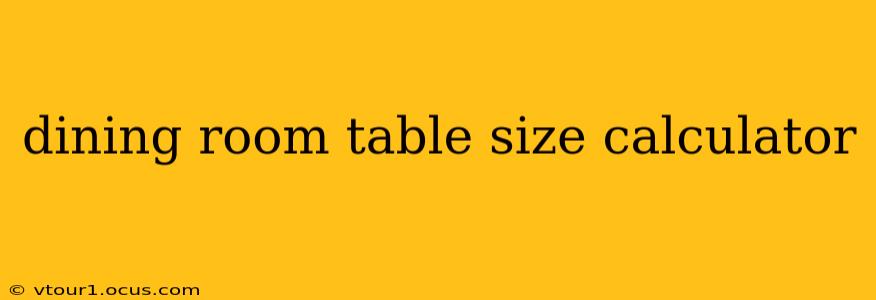Choosing the right dining room table can transform your space from ordinary to extraordinary. But with so many shapes, sizes, and styles available, finding the perfect fit can feel overwhelming. This comprehensive guide will help you navigate the process, using a practical approach to determine the ideal dining room table size for your needs and space. We'll even explore how to use a dining room table size calculator (though the real work is in understanding the factors below!).
What Size Dining Room Table Do I Need?
The most important factor in choosing a dining room table size is how many people you need to seat, and how much space you have available. Don't just focus on the number of seats; consider comfort. Allowing ample space for each person ensures a pleasant dining experience.
A good rule of thumb is to allow 24-30 inches of space per person around the perimeter of the table. This allows for comfortable seating and enough room to move plates and serve dishes without feeling cramped. For a more generous arrangement, especially if you often host larger gatherings, you might consider 36 inches per person.
How Much Space Do I Need Around My Dining Table?
Beyond the table itself, you need to consider the space surrounding it. You'll want enough room to pull out chairs comfortably and still have enough space to move around freely. A minimum of 36-48 inches of clearance around the table is recommended to allow for easy access and movement. This is especially important if you have a buffet or serving area nearby.
What is the Ideal Table Shape for My Dining Room?
The shape of your dining table significantly impacts the space it occupies and how people are seated. Here's a brief overview:
- Round Tables: Offer a more intimate and conversation-friendly setting, ideal for smaller spaces. However, they can be less efficient in terms of space utilization compared to rectangular tables.
- Square Tables: Efficient space utilization, suitable for smaller gatherings or spaces, but less versatile than rectangular options.
- Rectangular Tables: The most common choice, offering a balance between seating capacity and space efficiency. Versatile and accommodates larger gatherings.
- Oval Tables: Combine the intimacy of round tables with the efficiency of rectangular tables, suitable for medium-to-large gatherings.
What About Leaf Tables?
Extendable tables with leaves are fantastic options for those who occasionally host larger gatherings. They offer flexibility, allowing you to adapt the table size to your needs. Consider the stored leaf size and the overall extended dimensions to ensure that it fits within your space even when expanded.
How do I measure my dining room for a table?
Measure the dimensions of your dining room, noting any obstructions like fireplaces, doorways, or built-in units. This will help determine the maximum size of the table you can comfortably fit in the space. Remember to consider the clearance needed around the table for chair movement.
What is the minimum space needed between the table and the wall?
You ideally need at least 24-36 inches between your dining table and any walls, or other furniture pieces to allow enough room to pull out chairs easily without bumping into anything.
Can I use a dining room table size calculator online?
While numerous online dining room table size calculators exist, it's crucial to remember these are merely guidelines. The best way to determine the perfect size is through a combination of using online calculators as a starting point and careful measuring and consideration of your personal needs and preferences. The online calculators typically ask for your room dimensions and the number of people to be seated, but they may not fully consider factors like the chair sizes, walking space required, and your personal preferences regarding comfort levels.
How much space do I need per person at a rectangular table?
As mentioned earlier, aim for at least 24-30 inches per person at a rectangular table, ensuring comfortable seating and space for plates and serving dishes. For larger or more formal gatherings, consider 36 inches.
What is the best way to determine the right size for my dining table?
The best approach is a combination of careful measurement of your space, consideration of your seating needs, and evaluation of the different shapes to suit your space and lifestyle. Using online tools as a starting point helps, but shouldn't replace thorough in-person measurement and critical thinking. Remember to prioritize comfort and functionality. Choosing the right dining table is a crucial aspect of designing a comfortable and functional dining space, ultimately impacting the overall atmosphere and enjoyment of your home.
